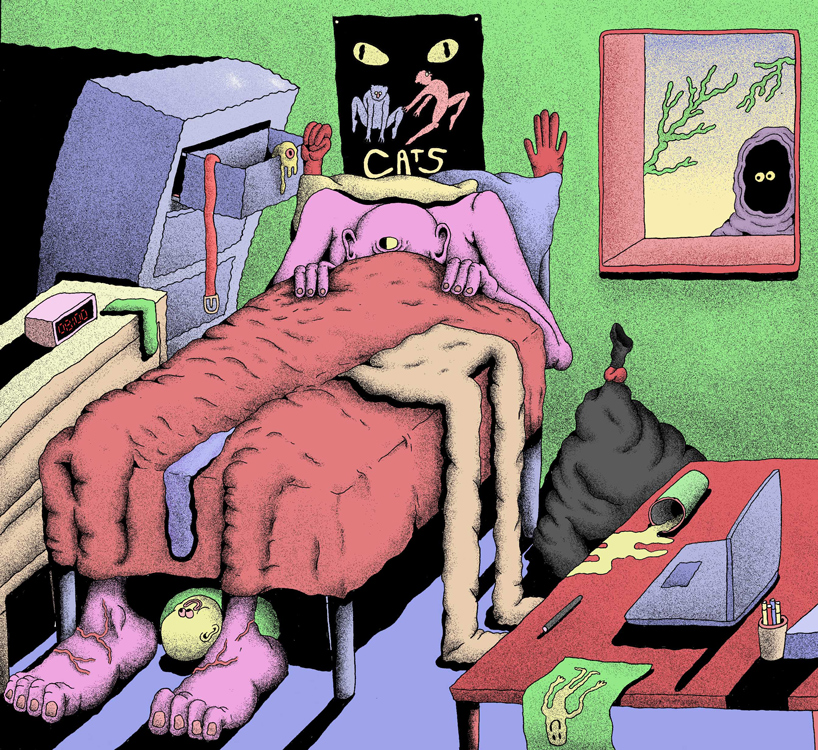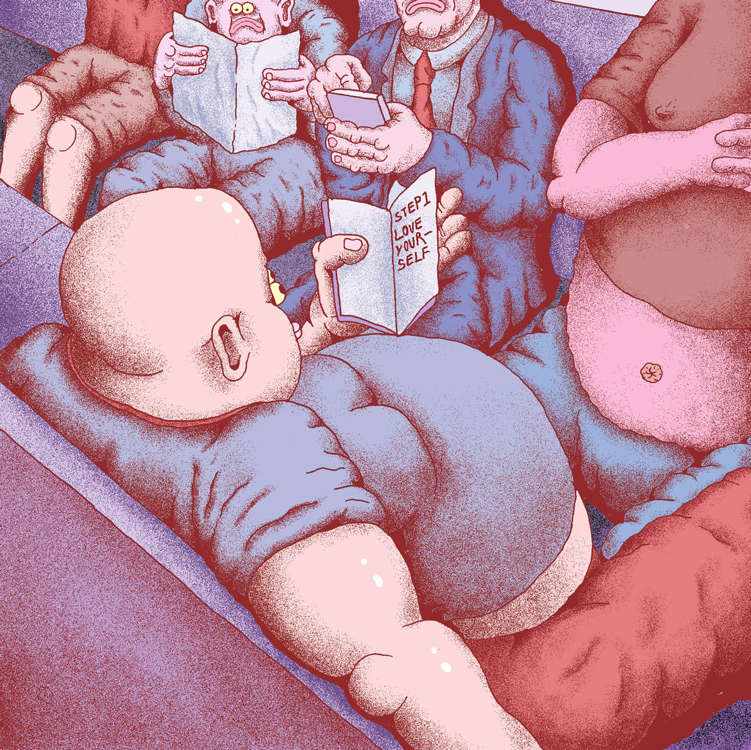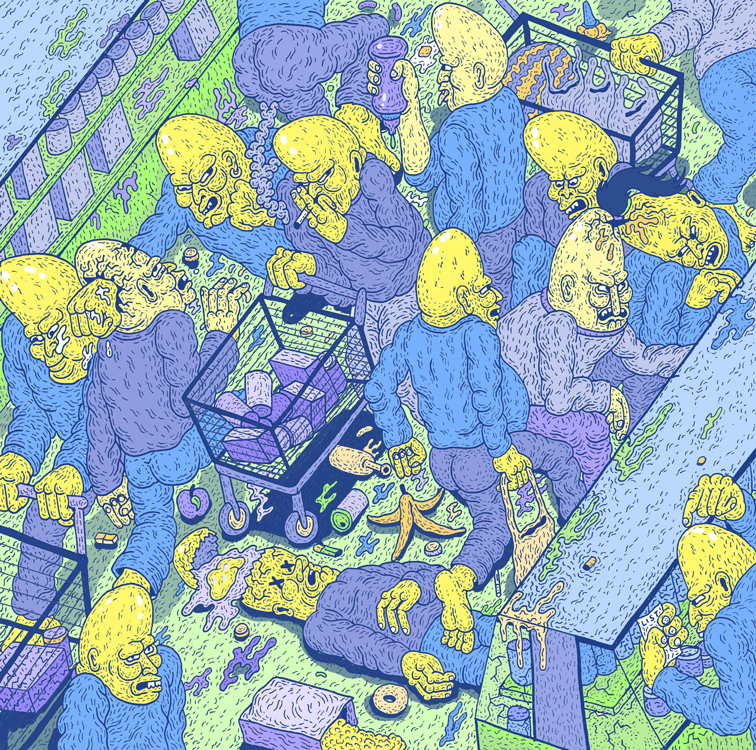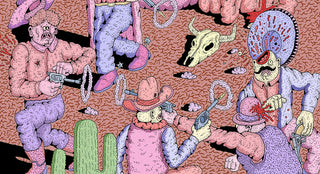The work of London-based illustrator and artist Alex Jenkins looks like an acid trip. There are car crashes and police shootouts, goblins on Grindr, violent swans, and Greek gods (from Poseidon to Pan) in all-out orgies. The colors—such as lavender cactuses, peach skies, and mauve, phosphorescent forests—also add to the illusory feel, as does Jenkins’ dots and squiggly lines, which make each scene appear as if it’s in motion. “I developed my style through a big, packed-together fleshy mass of all the influences I have registered or the things that appeal to me,” explains the artist, who cites Robert Crumb and Goya as influences.
But what appeals to Jenkins is different than what appeals to most artists. Instead of focusing on the attractive, Jenkins hones in on the repulsive, such as the number of people who hack up their lungs in public. “I focus on the things that are grotty around me,” he explains, in British slang, “and attempt to make a naïve commentary or criticism of it.” He injects his commentaries with a dose of humor, which makes semi-serious topics, such as exploding e-cigarettes and DIY STD treatments, seem more absurd and surreal. “I think it’s really important to find a balance,” he says in the following interview with The Hundreds. “So if I create something that’s full of gore, I try to put a comical element in place to balance it out. I don’t want to over-egg the pudding.”

Duel
Were you interested in art as a child?
I always drew when I was a kid. I think I liked the idea of having a running narrative, so I’d attempt my own comics, but my attention span would only last until the third frame in and I’d want to start afresh. These comics would usually be about gangsters, Predator—as in the sci-fi film—or my own take on an alternative Dragon Ball Z. I also would map out battle scenes with small figures, tanks, etc., and draw the missiles firing out of the various weaponry whilst making sound effects as though it were a live-action sequence. Typical little boy stuff, I guess. I didn’t really draw through my teens, as it wasn’t something common with my peers at my crap south London state school. It wasn’t until I left school, with barely any qualifications, and was on route to becoming a manager at a supermarket that I thought, “This ain’t for me,” and decided to do an art foundation in my early twenties.
How did you develop your distinct style?
I think that constantly drawing helps you to develop a certain language in what you’re doing. In my own personal style, I always like to have the key components of things that are slightly unnerving or grotesque, which are balanced out with an element of humor.

Bed
Which artists have had the most influence on you?
When I was about 20, my uncle bought me the R. Crumb Handbook for a Christmas present. This really was a slap in the face (in a good way), and I immediately connected with it. I think it was a mix of the grotesque humor, his intricate style, and the absurdity of his work that really appealed. For the first time, I was seeing work that had all the characteristics of the low-brow genre, yet could be passed as high art—it was brilliant! Also, there are a few artists that I can remember vividly when I was a young’n, and that’s Goya—the one that really stuck as a child was his “Saturn Devouring His Son”—Philip Guston, and Giorgio de Chirico, namely his piece “The Uncertainty of the Poet,” which is on permanent show at the Tate Modern. There was something about its sinister, dreamlike quality that resonated. There are so many other artists, but the ones at the top of my head are George Grosz, Otto Dix, Gilbert Sheldon, Bosch, Bruegel, and Max Fleischer.

KK
What are your illustrations about? What themes do you find yourself returning to again and again?
I am conscious of changing things up, but I guess you could say one common theme is having a slightly unnerving element in place. Whether it’s a grotesque feature, vulgar humor, or something slightly macabre. I don’t know exactly why, but I guess it’s something that appeals to me, and as an illustrator, you usually bang out the stuff that you lean towards.
How does technology influence your art? I’ve noticed there are a lot of smartphones in your work...
Ha! Yeah, I noticed that as well! I suppose it’s quite an obvious theme or criticism, but when we are surrounded by social media and technology, sometimes you can’t help but comment on it. I personally spend so much time swiping on my phone, that I think that subliminally it must pass through my brain, so when it gets to the point where I’m contemplating or racking my mind on what to draw, that’s almost a theme that will often automatically pop up.
Don’t focus on the perfected finish, as you’ll improve as you go.
Can you describe your process? Do you plan everything out in advance or do you sort of make things up as you go?
I often wish that my brain was advanced enough where I could write things down in a little notebook or do a “note to self” in a Dictaphone and come up with ideas throughout the day, but, unfortunately, my mind remains a baron wasteland. Usually, I’ll sit at my desk or wherever I’m drawing, bereft of ideas, and then start to doodle. When something comes up that I like, it sort of develops into an idea from there. Although, occasionally, there will be an idea at the back of my mind that can sometimes sprawl later onto the paper. For example, I have always noticed the amount of people that hack up their lungs and phlegm on the floor in London, so then that could serve as an idea that would be logged in a deep crevice of my head.

Supermarket
What do you consider the highlight of your art career so far?
I think my highlight would be the first time I received an editorial commission, which would basically be the first time I was paid for something that I drew. I remember the initial feeling of panic, then excitement, and then panic again. Overall it seemed to go quite well, even though I was a nervous wreck when completing it.
What is one thing that you haven’t done that you would love to do?
I used to have this fantasy that I’d one day be a world champion boxer. It whirled around in my head until I actually got in the ring and didn’t gauge the distance; the other guy popped my nose with the first punch. I then realized that I wasn’t fit, and probably not good enough to pursue this fantasy. It’s like the Mike Tyson saying, “Everyone has a plan till you get punched in the mouth.” There is still something in me, though, that re-enacts those Rocky-style fantasies. Usually in my underpants.
What is your best piece of advice for aspiring illustrators or artists?
It’s really important, and I can’t stress enough, to keep drawing as much as possible. Don’t focus on the perfected finish, as you’ll improve as you go. It’s one of those things where you reflect and see your progress after a certain point, but when in the midst, it’s often easy to lose heart. A tutor once told me to not “hide away in a cave,” and keep producing and getting your work out there, whether it’s in a zine, a blog, on social media... It always helps your confidence once people see your work. Think of it as a statistic: Out of 100 people, 10 people might hate it, 87 people could be “meh” and not fussed, but there’s that final three that love it and connect. So go out there and find that three.
***
See more of Alex’s work at alexgamsujenkins.com and on Instagram @alexgamsujenkins.

